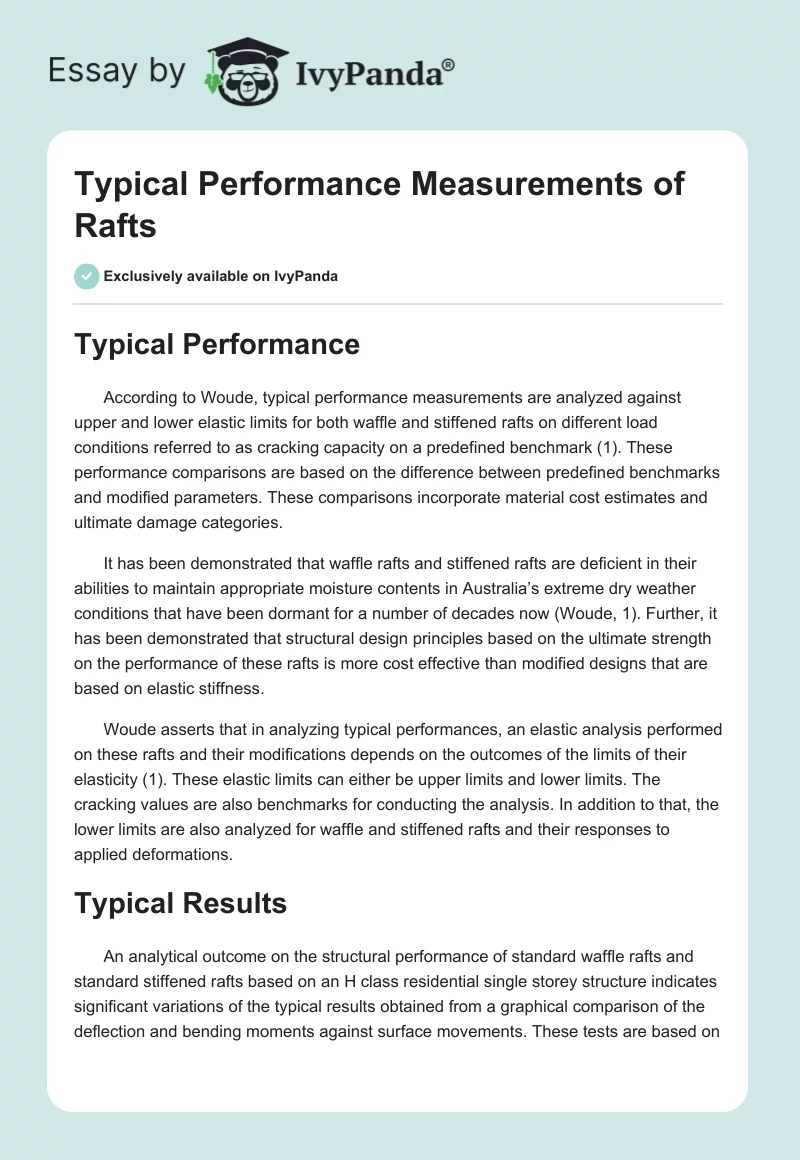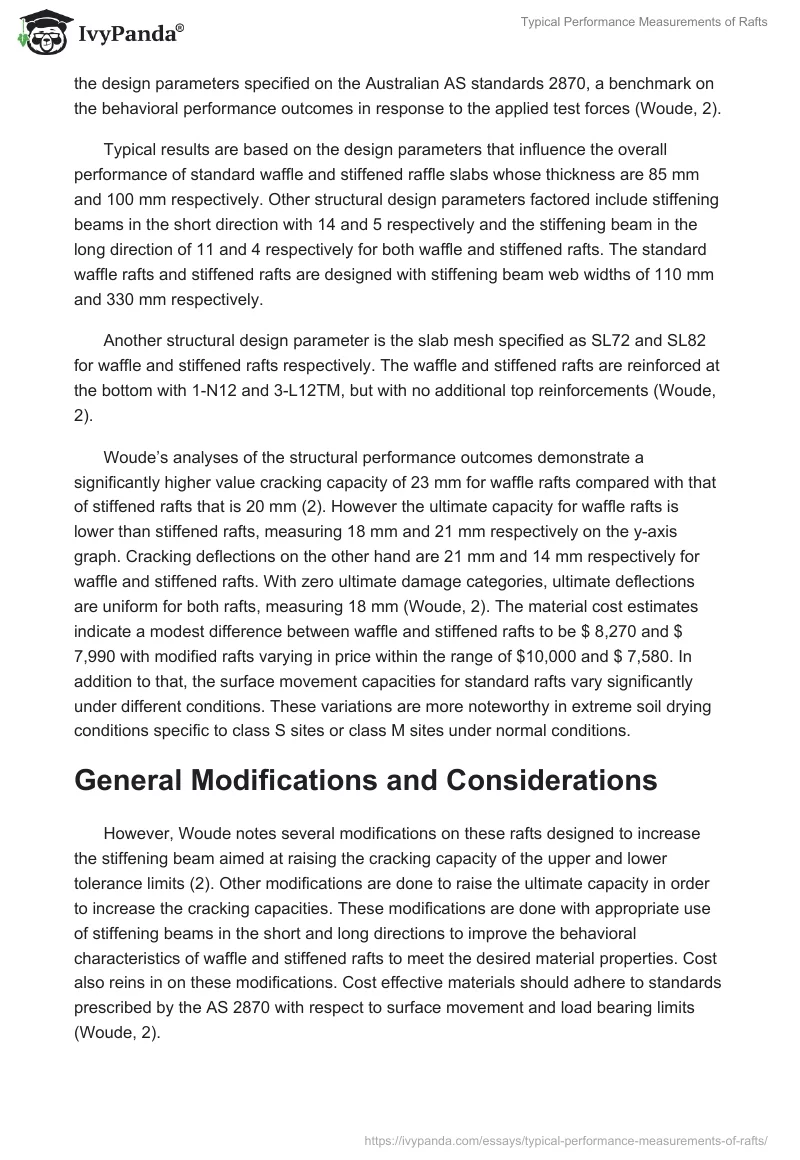Typical Performance
According to Woude, typical performance measurements are analyzed against upper and lower elastic limits for both waffle and stiffened rafts on different load conditions referred to as cracking capacity on a predefined benchmark (1). These performance comparisons are based on the difference between predefined benchmarks and modified parameters. These comparisons incorporate material cost estimates and ultimate damage categories.
It has been demonstrated that waffle rafts and stiffened rafts are deficient in their abilities to maintain appropriate moisture contents in Australia’s extreme dry weather conditions that have been dormant for a number of decades now (Woude, 1). Further, it has been demonstrated that structural design principles based on the ultimate strength on the performance of these rafts is more cost effective than modified designs that are based on elastic stiffness.
Woude asserts that in analyzing typical performances, an elastic analysis performed on these rafts and their modifications depends on the outcomes of the limits of their elasticity (1). These elastic limits can either be upper limits and lower limits. The cracking values are also benchmarks for conducting the analysis. In addition to that, the lower limits are also analyzed for waffle and stiffened rafts and their responses to applied deformations.
Typical Results
An analytical outcome on the structural performance of standard waffle rafts and standard stiffened rafts based on an H class residential single storey structure indicates significant variations of the typical results obtained from a graphical comparison of the deflection and bending moments against surface movements. These tests are based on the design parameters specified on the Australian AS standards 2870, a benchmark on the behavioral performance outcomes in response to the applied test forces (Woude, 2).
Typical results are based on the design parameters that influence the overall performance of standard waffle and stiffened raffle slabs whose thickness are 85 mm and 100 mm respectively. Other structural design parameters factored include stiffening beams in the short direction with 14 and 5 respectively and the stiffening beam in the long direction of 11 and 4 respectively for both waffle and stiffened rafts. The standard waffle rafts and stiffened rafts are designed with stiffening beam web widths of 110 mm and 330 mm respectively.
Another structural design parameter is the slab mesh specified as SL72 and SL82 for waffle and stiffened rafts respectively. The waffle and stiffened rafts are reinforced at the bottom with 1-N12 and 3-L12TM, but with no additional top reinforcements (Woude, 2).
Woude’s analyses of the structural performance outcomes demonstrate a significantly higher value cracking capacity of 23 mm for waffle rafts compared with that of stiffened rafts that is 20 mm (2). However the ultimate capacity for waffle rafts is lower than stiffened rafts, measuring 18 mm and 21 mm respectively on the y-axis graph. Cracking deflections on the other hand are 21 mm and 14 mm respectively for waffle and stiffened rafts. With zero ultimate damage categories, ultimate deflections are uniform for both rafts, measuring 18 mm (Woude, 2). The material cost estimates indicate a modest difference between waffle and stiffened rafts to be $ 8,270 and $ 7,990 with modified rafts varying in price within the range of $10,000 and $ 7,580. In addition to that, the surface movement capacities for standard rafts vary significantly under different conditions. These variations are more noteworthy in extreme soil drying conditions specific to class S sites or class M sites under normal conditions.
General Modifications and Considerations
However, Woude notes several modifications on these rafts designed to increase the stiffening beam aimed at raising the cracking capacity of the upper and lower tolerance limits (2). Other modifications are done to raise the ultimate capacity in order to increase the cracking capacities. These modifications are done with appropriate use of stiffening beams in the short and long directions to improve the behavioral characteristics of waffle and stiffened rafts to meet the desired material properties. Cost also reins in on these modifications. Cost effective materials should adhere to standards prescribed by the AS 2870 with respect to surface movement and load bearing limits (Woude, 2).
Therefore, other general considerations play a key role in meeting these requirements. These include soil-structure interactive stiffness, the lift-0ff distance and edge distance, stiffening beam and beam spacing with an effective flange width, and slab thickness and stiffening beam web width.
The foundation system and the relationship lying between the elastic stiffness and ultimate strengths specific of the structure of the soil analytically determines the transition between elastic and ultimate strengths. Elastic performance is significantly determined by a non-dimensional ratio of the product of the modulus elasticity of concrete and the stiffening beam length divided by the product of the modulus of elasticity of soil and the product of the squares of the stiffening beam length (Woude, 3). On the other hand, edge distance and lift off distance distinctly provide a comparative analysis of the elastic behavior against edge movement. Therefore in this analysis, lift-off distance and edge distance analyzed against edge movement indicate a both the edge distance and lift off distance to converge towards a point (Woude, 3).
On the other hand, Woude asserts that a flange width that is effective for the bending beam determines the bending movement, the surface movement, and ultimate bending movement. An effective flange width influences spacing for the amount of spacing for stiffening beams. On the other hand, standard waffle rafts are known to have more stiffening beams compared to the stiffened rafts that have fewer stiffening beams (Woude, 3).
A comparison between waffle and stiffened rafts on slab thickness and beam web width indicates that the lower limit of slab thickness is governed by concrete cover and steel reinforcements for appropriate compaction and placement. However, loading conditions determine the lower limit of slab thickness with a specific example being load concentrations on an isolated slab panel.
The specific structure is additionally reinforced at the top by top reinforcement bars tied to the conventional bars whose spacing is even in the range of effective flange width of internal stiffening beams in the short direction (Woude, 3). These provide cover for any potential cracks. Either N12 bars or N16 bars are used to provide appropriate compaction between parallel bars. According to Woude, the slab mesh should be made to meet the minimum ductility requirements specified in the AS 2870 standard conventions if the slab is reduced to lower diameter level (3).
This analysis indicates a need to shift in structural design principles with regard to the elastic behavior of these materials particularly the ultimate stiffness that is clearly demonstrated as a cost strategy in Australia’s unforgiving weather conditions.
Works Cited
Woude, Frank Van der. Structural Performance, analysis, and design of residential slabs on moisture reactive soil. RAFT software Pty Ltd, Mount Glorious, QLD, Australia. 2007.


